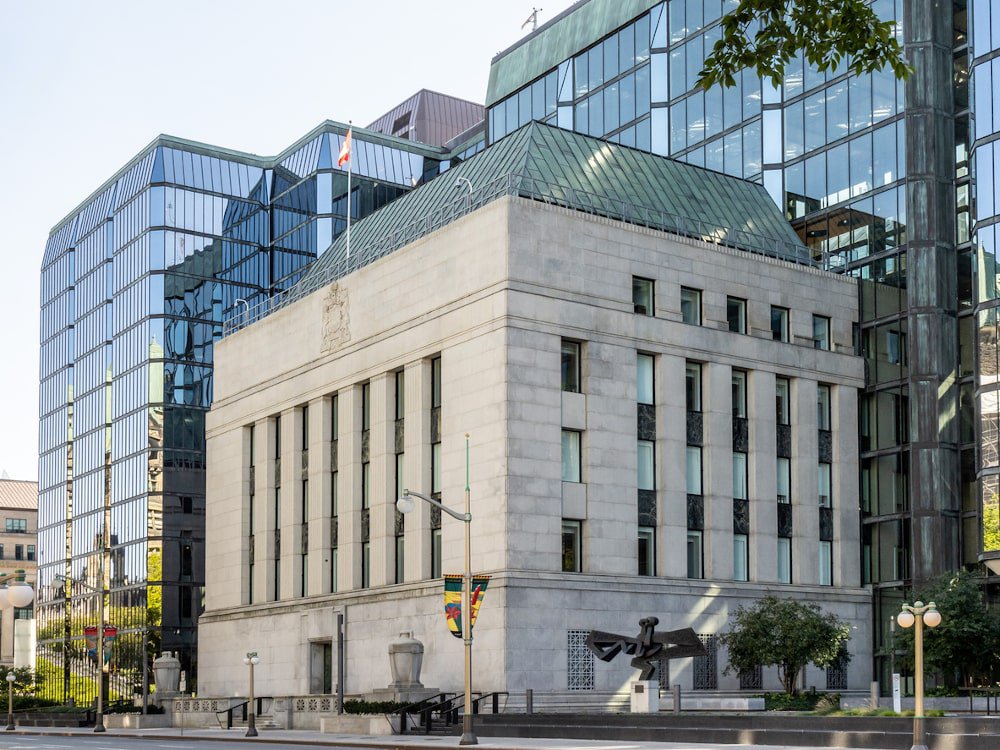What Determines Bank of Canada Interest Rates?

Have you ever wondered what controls the economy? Global events? Consumer trends? Innovation? While there are a number of factors shaping our macro-environment on a daily basis, perhaps the most important and impactful one is the interest rate.
In Canada, the overnight lending rate, also known as the policy rate, is an interest rate set and announced by the Bank of Canada (BoC) at eight pre-scheduled meetings throughout each year. The overnight lending rate can affect mortgages, savings accounts, loans, and more, impacting several aspects of an average Canadian’s daily life. The BoC primarily uses the policy rate to either cool down or heat up the economy, depending on the current needs of the market.
The Mechanism Behind BoC’s Rate Decisions
On a fundamental level, the policy interest rate represents the rate that commercial banks charge one another with for overnight loans. For instance, if any commercial bank finds themselves over-drafted, they may need to borrow funds from the central bank (BoC), or from another commercial bank (e.g. TD might take out a loan from RBC). The policy interest rate represents the target rate that the BoC wants the banks to charge each other for this loan, hence why it is sometimes referred to as the overnight lending rate.
The Bank of Canada can alter the overnight lending rate throughout the year (on pre-determined days) in order to further their desired monetary policy. For instance, the BoC may raise rates in an inflationary environment , or lower it in times of recession — to jumpstart the economy. While the public is not privy to every part of the decision-making process, the BoC does release a Monetary Policy Report every quarter, providing insights into their interest rate decisions.
Economic Indicators Affecting Interest Rates
Three major indicators taken into account when looking at interest rates are as follows: gross domestic product (GDP), inflation, and jobs growth.
Growth Domestic Product: measures the overall health of the economy. Strong GDP growth may show signs of the market heating up too much, meaning interest needs to be raised to slow it down. Whereas weak GDP prompted a decreased rate to boost it up.
Inflation Rate: shows the rate at which prices of goods and services rise. The BoC aims to keep inflation around 2%, but it has risen tremendously since March 2021; at which the highest it reached was 8.1% in June 2022.
Jobs growth: the level of jobs being added or removed from the economy can be used to predict the market. Little to low job addition to the market signals a tough time for workers, leading to fewer economic activity, and requires lower interest rates to help the economy regain its position. Whereas lots of jobs added to the economy hint wage increase, more economic activity, and requires an increase of interest rate to cool down the market.
Role of Inflation and Employment Data
Inflation and employment data are crucial to BoC’s interest rate determination process. Rising inflation, coupled with rising employment opportunities, often signals a need for the Canadian economy to be cooled down. In response to such an environment, the BoC may increase interest rates to reduce consumer spending, and thereby slow inflation. On the flip side, an economy facing rising unemployment statistics may need to be revitalized through an interest rate drop. This helps encourage borrowing, spending, and investing — stimulating the economy.
Whether you are looking to invest in real estate, or simply manage your savings, understanding the market dynamics connecting inflation to employment to interest rates is crucial. One of the best ways to do this is by staying up to date with any upcoming changes in the market. For instance, paying attention to the next interest rate announcements, which will take place on June 5th, July 24th, and September 4th.
By closely monitoring economic indicators and BoC announcements, our Clover Mortgages team also helps clients make informed decisions to align with Canada’s ever-changing real estate landscape. To learn more, contact us today to schedule a free consultation.
FAQ
Who controls Canadian interest rates?
The Bank of Canada controls the interest rates in Canada.As our nation’s central bank, the BoC sets the benchmark cost of borrowing money — to influence the economy in line with their monetary policy. The BoC may adjust rates to manage inflation and to maintain economic stability. These changes can affect everything from mortgage rates to the value of the Canadian dollar.
What determines a bank’s interest rate?
A bank’s interest rate is determined based on factors, like: the central bank’s overnight rate, market condition, and risk assessment. The BoC sets the benchmark rate, which then influences the rates banks charge for loans and offer on deposits. Banks may also change their interest rates for market-related reasons. For instance, a bank may lower their rate to attract borrowers in a competitive market.
Can banks decide their own interest rates?
Interest rates that commercial banks use are heavily influenced by the Bank of Canada prime rate. Most banks use the “prime plus …” rate for their lending. Therefore, while banks follow the broader economic conditions set by the central bank, they have flexibility to adjust their rates to optimize their profitability and market position.





